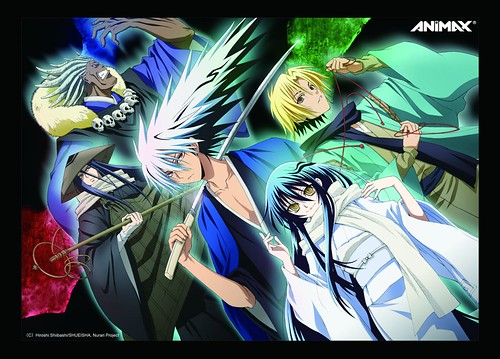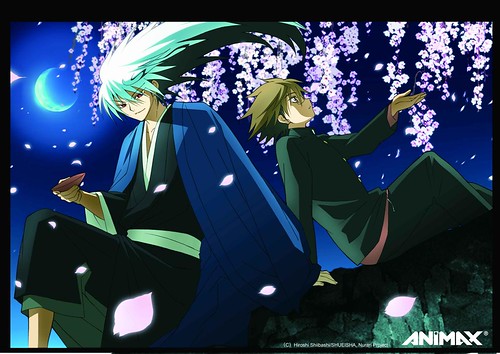Plot summary; Rikuo Nura is 3/4 human and 1/4 yokai. He has a human form in the day however at nights he changes to a yokai. Also he lives in a house filled with yokai, with his grandfather who is a yokai. Trying to escape his fate, he does good deeds in order to avoid becoming a yokai, despite his wish that Rikuo succeed his as the Third Head of the Nura Clan. Rikuo is different because he helps humans unlike most yokai, that just scares himans to feed out their "fear". He eventually comes to terms with his yokai blood and decides to take up the position of the Third Head of the Nura Clan. Multiple Factons aim to stop him or usurp his position, and he must gather friends allies, a new Hyakki Yako. Hyakki Yako is a legend that every year yokai led by the yokai Nararihyon , will take to the streets during the summer nights. Anyone that stumbles upon this parade would die. In the anime Rikuo would develop a new Hyakki Yako or the Night Parade and become it's leader the Lord of Pandemonium.
For a shounen action series, Nura: Rise of the Yokai Clan's first thirteen episodes are surprisingly low-key and comfortable while still containing enough action to keep the viewer interested. Based on the manga of the same name by Hiroshi Shiibashi, the series follows unassuming twelve-year-old Rikuo Nura. Rikuo is one-quarter yokai, a fact which enables him to transform into “Night Rikuo,” an older, powerful demonic version of himself, although it may be more accurate to say that Night Rikuo is trapped within Day Rikuo. In any event, Rikuo just wants to be a normal human boy and resists his grandfather's plans to make him into the third clan head. This being the kind of story it is, Rikuo soon learns that his rejection of his yokai heritage has serious consequences not only for the yokai clan, but also for his human friends. This forces him to rather quickly accept who he is, a decision he comes to with what feels like a little too much ease. Nevertheless, as Rikuo comes to terms with both halves of himself he begins to focus on using both his human and yokai strengths to keep those cares about safe.

The show doesn't really pick up steam until around episode three, when the first of the outside forces really begin to pose a threat to Rikuo's friends and family. Previous to that we have an episode which introduces Rikuo's school friends and their de facto leader's obsession with yokai and then another which tries to up the stakes for episode three's battle. While both have their strengths – parts of the first are very funny as Rikuo tries to keep his friends from seeing actual yokai – neither are likely to really hook a viewer who has no background in the story. The first episode also makes an attempt to position romantic interest Kana as an unbeliever in the supernatural; while this might have worked, later developments in this set of episodes makes that initial attempt feel awkward as Kana's role increases and her interactions with yokai become more important to the plot.
Luckily once the plot does pick up it has a number of factors that keep it interesting. Episode nine's resolution and explanation of the Gyuki arc does a nice job of tying things together as well as showing us Night Rikuo's past with the villain and the romantic subplot wherein Rikuo becomes his own rival is well done. (It is worth noting that Kana herself is also conflicted about this, which feels like a fairly realistic depiction of a thirteen year old's crush.) The story moves fairly quickly through bad guys, which can make things seem rushed in places, such as with the bakeneko and their relationship to the rats, but it does keep the story moving along.

Visually the blu-ray looks quite nice, with crisp and bright imagery that really lets you feel the edge on a sword. Small details in the animation, such as Yuki-Onna limping after her foot has been injured, help to take the sting out of more stilted moments, and the fact that the bakeneko all move in a very feline way adds interest to their episodes, which otherwise can feel like an excuse to draw people with cat ears. The yokai themselves are all interesting to look at, from watching the mechanics of the neckless Kubinashi (the scene of him on the train is great) to the Day of the Dead style of the mirror demon. The three lead girls have believable middle school bodies, and really only Kiyotsugu, Rikuo's yokai-obsessed friend, looks out of place. The fact that the rat yokai all disguise themselves as hosts is a nice bit of visual wordplay as well, added to by having Takehito Koyasu voice the lead host rat.

In terms of the other voices, both dub and sub have different strengths. Overall the sub is a little stronger, mostly because episodes nine and ten suffer from awkward scripting and performance. Stand out dub voices are Cassandra Lee (PMMM's Kyubey) as Yuki-Onna and Wendee Lee as Natto-Kozo, although that character's sub voice, Satomi Arai, is equally good. The weakest dub voice is Sam Regal as Kiyotsugu, although it is important to mention that he isn't so much poorly performed as incredibly annoying. (If this was the goal, well done, Mr. Regal.) The theme songs are catchy, with the opening being strangely soothing.

As far as the actual discs themselves go, pausing for more than a minute caused disc one to freeze completely until rebooting the player was the only option. As this did not happen with disc two, it seems unlikely to have been my player, although that is still a possibility. There is no “signs and songs” subtitle track option, which is annoying, as to see the song lyrics or Japanese text you must either watch it subbed or with the full English subtitles over the dub track. Extras are a bit thin, with full and part color production sketches, a trailer, and a clean opening as well as a Neon Alley trailer. It is also worth mentioning that you are technically only getting twelve episodes, as episode thirteen is a clip show.
On the whole, Nura: Rise of the Yokai Clan's first blu-ray set is an entertaining show that is slower paced than your average action series. With interesting background characters, a generally likable set of major players, and a mostly inoffensive English dub, this is nice diversion that's a little more toned down than other Shonen Jump fare. This show isn't “screamy” in either dialog or plot and it looks nice – an overall comfortable viewing experience.
http://www.animenewsnetwork.com/review/nura/rise-of-the-yokai-clan/blu-ray-set-1
ALL in all i give it a 10/10.....Watch it !!!..........for more infor. http://nurarihyonnomago.wikia.com/wiki/Nurarihyon_no_Mago
ALL in all i give it a 10/10.....Watch it !!!..........for more infor. http://nurarihyonnomago.wikia.com/wiki/Nurarihyon_no_Mago
